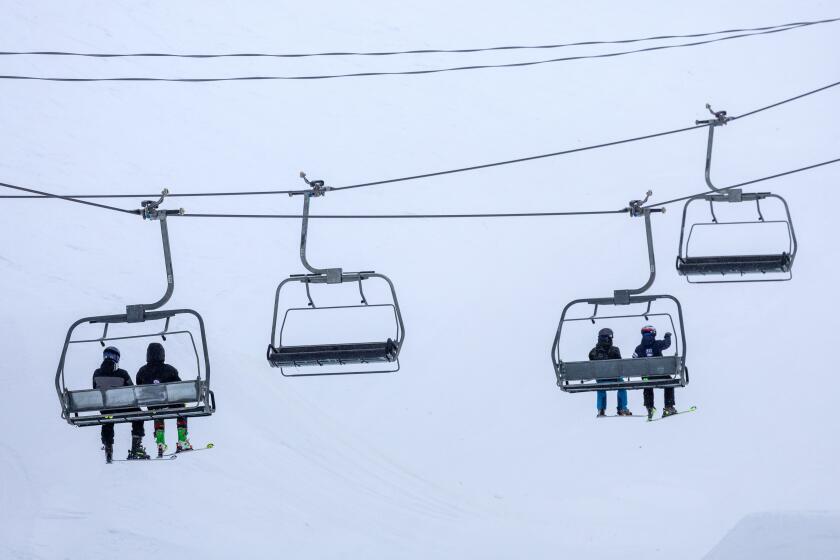Pilot in Fatal Crash Was Not Rated for Instrument Landing
- Share via
Orange County developer Walter Scott Biddle, who died when he crashed his light plane in foggy weather last Wednesday night trying to land at John Wayne Airport, was not legally qualified to fly by instrument control, according to the Federal Aviation Administration.
Nevertheless, Biddle, 58, had received clearance to land under instrument flight rules, which require a pilot to navigate his craft based on his plane’s instrument readings, said Gary Mucho, chief of the National Transportation Safety Board’s Los Angeles office.
Because of poor visibility around the airport, only pilots with flight instrument ratings were permitted to take off and land, Mucho said.
“Before you can properly execute and perform an instrument procedure, you should have the proper qualifications . . . certificates and training,” Mucho said.
Air traffic controllers presume that a pilot requesting permission for instrument landing is properly certified to perform one, Mucho said. However, pilots without proper certification all too often attempt it, he said.
“Unfortunately,” said Ralph Odenwald, FAA air traffic manager of the John Wayne Airport tower, “a lot of general aviation accidents are the result of non-instrument-rated pilots trying to fake it or finding themselves in a situation” requiring instrument control.
Crash Still Being Analyzed
The official cause of last week’s plane crash will not be known for months, as safety board investigators collect and analyze information, then pass it on to the safety board in Washington for a determination.
Memorial services were held Tuesday for Biddle, chairman of Biddle Development Inc. of Irvine, who helped build more than 10,000 homes in Orange and San Diego counties, and as far north as Sacramento.
Attempts to reach Biddle’s family Tuesday were unsuccessful.
Mucho said Biddle had taken off from Visalia under visual flight rules, in which the pilot uses the horizon and other visual references to guide the craft in clear weather. But “somewhere en route,” Biddle received clearance to land at John Wayne Airport under instrument flight rules, Mucho said.
Ron Morgan, an FAA manager in the Los Angeles office’s air traffic division, likened the situation to “the person who goes out and drives a car without a license. Unless the policeman stops him because he’s doing something wrong, you don’t know” he is unlicensed.
Mucho said “there’s a lot of time and effort spent by (a) pilot getting an instrument rating, (which is) a detailed, exacting certificate to obtain. Once you get an instrument rating, you have to keep practicing at it.” Officials with the FAA’s airmen’s certification division in Oklahoma City said Tuesday, and the National Transportation Safety Board in Los Angeles confirmed, that Biddle had no instrument rating on his pilot’s license.
Bob Sexton, FAA supervisory applications examiner, said Biddle held a private pilot’s certificate issued Dec. 22, 1958, but never held an instrument rating.
Strobe Lights Not Operating
Meanwhile, FAA officials said they do not believe it was significant that five strobe approach lights leading to the John Wayne runway were not operating the night of the crash.
Although the strobes had malfunctioned, other approach lights as well as the lights that line the runway were working.
“With five strobes out, I don’t think that’s a significant factor,” Morgan said. “That’s an opinion on my part, and I’m also a pilot.”
FAA officials also downplayed the absence of radar monitors at the John Wayne tower the night of the crash. The tower’s radar was out of service while routine maintenance work was being performed.
The strobes and radar are not required by the FAA at the airport, and instrument landings can be made without them, Odenwald said. Several private and commercial planes had made instrument landings the same night of the crash, he said.
Under instrument flight rules, “the pilot is providing his own navigational guidance whether the tower is even manned or not,” Odenwald said.
Radar Not Used for Approach
Morgan said the John Wayne tower’s radar monitors are “not used for approach control purposes” but are instead used primarily by air traffic controllers to separate approaching aircraft and put them in a sequence.
And though the tower’s radar was not in service, Biddle’s landing approach was monitored by radar at the FAA approach control facility at El Toro Marine Corps Air Station, Morgan said.
Audrey Schutte, the safety board’s air safety investigator handling the case, said, “I see no significance in the fact they were out of service. . . . I do not see any way it could have contributed to this specific accident.”
Although the strobe lights may have provided more visual aid to Biddle as he made his approach, “you got to get through the clouds to see them first,” Mucho said.
Cloud cover was as low as 400 feet the night of the crash, which was one factor requiring instrument flight rules, FAA authorities said.
A safety board spokesman said last week that Biddle made “a missed approach” on his first attempt to land and was warned twice by air traffic controllers that he was too low on his second attempt.
More to Read
Sign up for Essential California
The most important California stories and recommendations in your inbox every morning.
You may occasionally receive promotional content from the Los Angeles Times.










